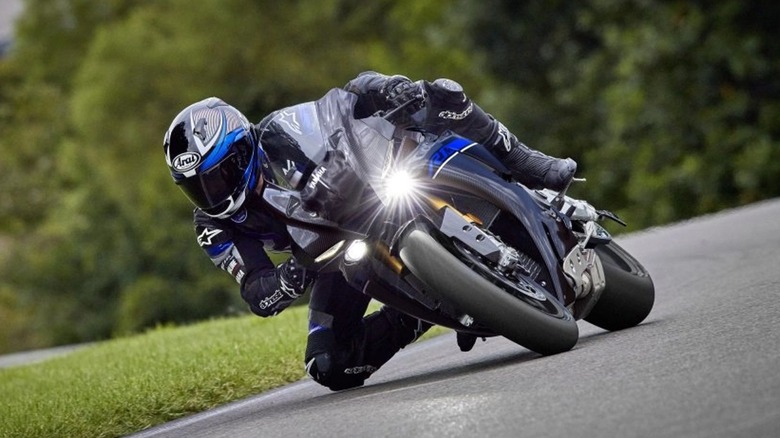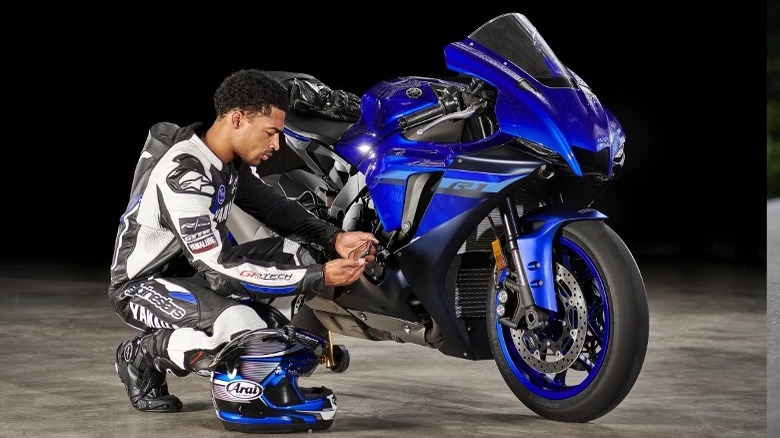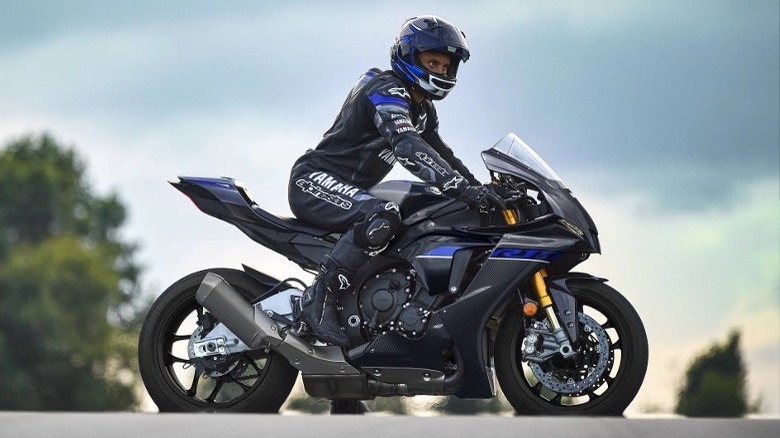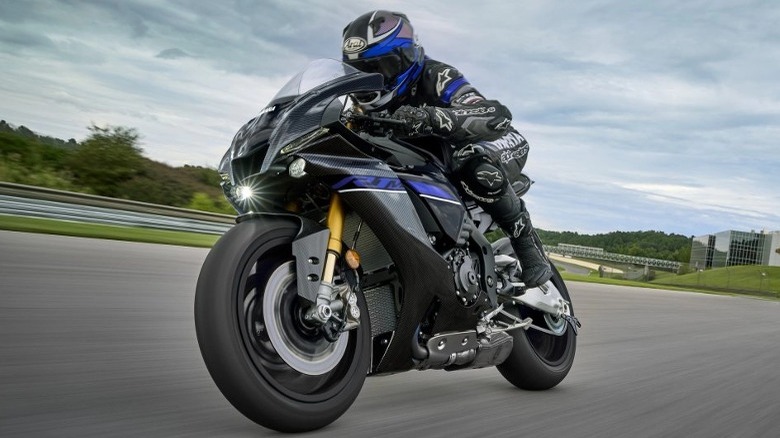Yamaha R1 Vs. R1M: What's The Difference Between These Top-Tier Supersport Bikes?
Yamaha makes all different kinds of motorcycles, but it is perhaps best known for its sports bikes. The company sponsors multiple racing teams, and its vehicles are frequently featured in Grand Prix races. Off the track, Yamaha also offers a lineup of sports motorcycles that range from easy-to-ride starter bikes all the way to high-performance Supersports. Out of all these, the YZF-R1 and the YZF-R1M are two of the most powerful commercial motorcycles that the company makes, sitting at the pinnacle of the YZF R-series lineup.
Naming conventions can be a little confusing across different motorcycle brands, so it's easy to see how someone might be a little confused about what exactly the difference between these two bikes actually is. They look pretty similar on the outside, and both of them are powered by a 998cc, liquid-cooled inline 4-cylinder DOHC engine. They both have a 6-speed transmission, Bridgestone Battlax Racing Street RS11 tires, and a 4.5-gallon fuel tank. There is only a 2-pound difference in their weight. They get the same 33 mpg mileage, and their reported dimension are nearly identical to within a fraction of an inch.
So why is it that the R1M costs a full $9,000 more than the R1 if these bikes have so much in common? Well, even though they both have the same engine and general design, there are a few key differences in their spec and feature sets that give the R1M a bit of an edge over its sibling.
The R1M has an Öhlins suspension
The biggest and most important difference between the R1 and the R1M is in the suspension system. The standard R1 uses a 43mm KYB inverted fork in the front and a KYB single shock in the back. KYB is a well-established entity in the motorcycle suspension world, but it's not the best on the market.
The R1M has a 43mm Öhlins Electronic Racing Suspension NPX fork in the front and an Öhlins Electronic Racing Suspension single shock in the back. Öhlins is a Swedish company that has been making racing suspensions since 1976 and is well regarded as one of the best suspension manufacturers on the market. There are a few technologies baked in that help explain why this system is so special.
Yamaha states that the Öhlins NPX system utilizes a pressurized nitrogen chamber similar to a rear shock. By doing this, "oil cavitation is essentially eliminated to deliver consistent damping under the toughest conditions with unmatched ride quality and feel." The Electronic Racing Suspension system also has IMU (internal measurement units) that send data from the suspension to a dedicated processor called an SCU (suspension control unit). This monitors factors such as speed, lean angle, acceleration, and breaking. It then transforms that information into real-time dampening adjustments in order to maintain even contact with the pavement and keep your ride smooth. The system is also highly customizable. It can be set to street, track, or manual mode, which allows you to fine-tune the performance to your specific needs.
The R1M has carbon fiber body work
The overall profile and dimensions of the R1 and R1M are very similar. Their fairings are shaped the same and even most of the more subtle details, such as shape of the wheels, are identical. Both bikes also place riders in the same aggressive, forward-leaning posture that you would expect to see from a sport bike of this caliber. There is an easy way to tell them apart without having to look for branding on the suspension, however.
"R1M riders are treated to even higher levels of fit and finish thanks to full carbon-fiber bodywork," says Yamaha. This includes "a carbon windscreen fairing, side fairings, front fender and tail section, matched to a polished aluminum swingarm and topped with a unique serial-numbered YZF-R1M badge on top of the airbox cover." These carbon fiber elements have a more textured design. They also give the bike a more dynamic color scheme than the solid blue and black options that are available on the standard R1. It doesn't do anything to alter the performance, but it gets points for style and is likely a major part of the reason why the R1M is one of the most popular 1,000cc motorcycles currently available.
The R1M has with GPS data logging
Now for the final major difference between these bikes. The R1M comes equipped with a CCU (communications control unit), which is not present in the standard R1. This is a GPS and tracking system. According to Yamaha, this system "puts factory superbike technology in the palm of your hand, complete with GPS-powered course mapping, automatic lap timing, and Yamaha Ride Control (YRC) mobile device adjustability."
GPS might not be all that structurally important — especially when compared to the upgraded suspension — but there is no denying its convenience. The R1M isn't really one of the best Yamaha motorcycles for long rides, but course mapping is handy for street riding, and it's always nice for a racetrack bike to have built-in lap timing. It's particularly nice for something like the R1M, which is targeted towards riders who want to push their bike's performance to its limits and then track what exactly those limits are.
All of this can be monitored and controlled via the Y-TRAC communication unit, the same place where you get information from the IMU and ECU. There is an app available on both iOS and Android that allows you to monitor these and even tinker with the system settings.



